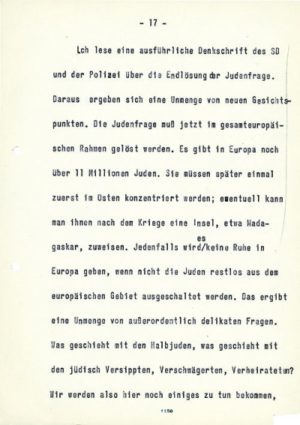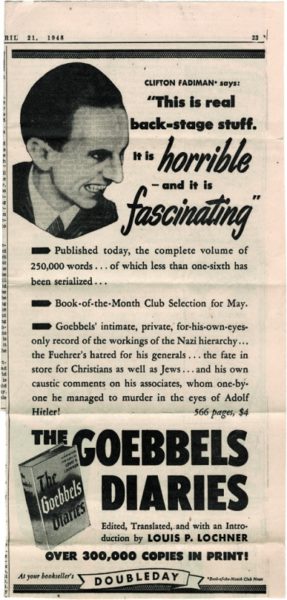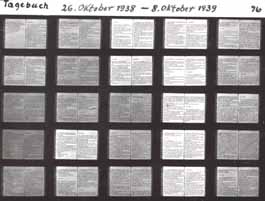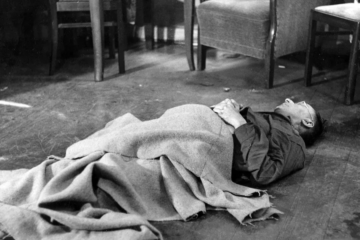The Hunt for the Goebbels Diaries
by Andrew Hamilton
IN TERMS OF a serious approach to the Jewish problem, the NS movement in Germany is clearly of primary historical significance. At the highest echelons, perhaps the three most important figures in this regard are Adolf Hitler, Heinrich Himmler, and Joseph Goebbels. These three men probably had a better grasp of the problem, and came closest to reciprocating the Jews’ unbending hostility, than any Whites before or since.
Goebbels was head of the Reich Ministry of Public Enlightenment and Propaganda (RMVP, Reichsministerium für Volksaufklärung und Propaganda) from 1933 to 1945.
After obtaining his Ph.D. in history and philology from the University of Heidelberg in 1921, he kept an extensive, detailed diary beginning in late 1923, when he was 26 years old, until his death in 1945 — a little over 21 years. He diligently added new entries almost daily, frequently devoting several hours to each new entry.
Goebbels’ diaries are by far the most voluminous and complete personal account left by any major figure in Hitler’s movement. Not even the second largest diary in print, Polish Generalgouvernement chief Hans Frank’s, approximates Goebbels’ in scope. Other diaries, such as those by Heinrich Himmler, Alfred Rosenberg, Hermann Göring, and Franz Halder, are more limited in scope.
In 1934, Goebbels published an edited section of his diaries in book form in German:
Joseph Goebbels, Vom Kaiserhof zur Reichskanzlei: Eine historische Darstellung in Tagebuchblattern (From the Kaiserhof to the Reich Chancellery: A Historical Account from the Pages of a Diary) (Munich: Eher-Verlag, 1934) — an authorized edition of parts of his diary from January 1, 1932 to May 1, 1933 that was translated into English as My Part in Germany’s Fight, trans. Kurt Fiedler (London: Hurst and Blackett, 1938).
In the preface he noted,
The German Revolution has imposed personal and material sacrifices on leaders and men, of which the public up to now has no idea. The peaceful unrolling of events often leads those who took no part in them to suppose that power fell into our laps like fruit, without us doing anything about it. This supposition is unfortunate, in that it ignores the wealth of sacrifice which the Movement, following its own compulsion, was bound to exact.
From October 1923 until July 1941, Goebbels’ diaries were handwritten. Authors from Louis Lochner to David Irving have had a difficult time deciphering his unique script. (Irving: “Dr. Goebbels’ handwriting is truly illegible. It took me two years to learn to read it.”)
By July 1941, the hand-written diaries filled twenty thick volumes, and Goebbels realized they were too valuable to risk destruction in an air raid. He therefore moved them from the study in his Berlin home to the underground vaults of the Reichsbank in central Berlin. From that time forward, he no longer wrote by hand but dictated all entries to a stenographer, Richard Otte, who later typed up corrected versions.

Large, unique typescript and unusually wide margins characterized the mechanically transcribed portion of the diary. It was developed for a nearsighted Hitler so that he would not have to wear glasses while reading speeches in public, and for Goebbels, that he might have sufficient space to make corrections in his diary.
It has been said that the involvement of a stenographer meant that the diaries were no longer secret, and as a consequence became less frank regarding doubts about Hitler’s leadership or highly personal matters than had previously been the case.
By 1943–44, it was apparent to Goebbels and others that Germany would lose the war. Aware that his diary constituted a remarkable historical document, he ordered it to be copied for safekeeping, using the newly-invented technique of microfilm. A special darkroom was created in Goebbels’ apartment in central Berlin with stenographer Richard Otte supervising the work.
Goebbels made the last entry on April 10, 1945, less than a month before his death. The original handwritten and typed diaries were packed and stored away in the Reich Chancellery. Apparently only a few pages of the paper diary survived.
The boxes of glass plates containing the complete microfilmed diary were shipped to Potsdam, west of Berlin, where they were buried. These boxes were discovered by the Soviets after the war and sent to Moscow, where they remained unopened until their discovery by German historian Elke Fröhlich in 1992.
Publication of the Complete Diaries in German
The definitive edition of Goebbels’ diary is available only in German:
Elke Fröhlich, ed., Die Tagebücher von Joseph Goebbels, 29 vols. (Munich: K. G. Saur Verlag, 1993–2008). Spanning the years 1923–1945, this edition is said to be 98% complete. Each published volume is about 500 pages long. The work is divided into 3 parts (or Teils): Part 1 1923–1941, Part 2 1941–1945, and Part 3 Register, 1923–1945.
The manuscript was not annotated, and only the barest of editing was done so as to preserve the authenticity of the text to the highest degree possible.
After having worked on the diary, Elke Fröhlich regards Helmut Heiber’s hostile biography (Goebbels, 1972) as essentially reliable (Mark Weber cites it as well), but dismisses the works of Jewish author Curt Riess (Joseph Goebbels: A Biography, 1948) and Roger Manvell and Heinrich Fraenkel (Doctor Goebbels: His Life and Death, 1960) as superficial. The latter two authors published numerous dubious biographies of Third Reich leaders.
According to Thomas Dalton, among scholars, only David Irving and Ian Kershaw have cited the complete diary to a significant extent. (Toby Thacker, Joseph Goebbels: Life and Death, 2009, also appears to have utilized the diaries.)
Dalton feels that “Irving [in Goebbels], especially in the longer Internet version, captures many important passages on the Jewish Question, but this is clearly not his main concern. Kershaw [in Hitler 1936–1945: Nemesis (2000)] has a large number of quotations, but most are only partial, out of context, and designed to cast a certain light on Hitler.”
Thomas Dalton wishes the diaries would be published “in English, in full, with an honest translation,” but does not expect it to happen. “I contacted the people at Saur in Germany, asking about this. I received a terse one-sentence reply: “The title Goebbels Tagebücher will not be published in an English version.” (Dalton e-mail correspondence with Martin Wolter, November 19, 2009.)
This follows a pattern of ideologically-motivated linguistic balkanization intended to limit the impact of specific ideas among Europeans, as in the conspicuous failure to translate into English Nobel Prize-winning author Aleksandr Solzhenitsyn’s Two Hundred Years Together (2003), or the works of NS ideologist Alfred Rosenberg.
The 1942–43 Transcripts & 1925–26 Handwritten Diary in Post-War Berlin
In the chaos following the Allied-Communist destruction of Berlin, the city was a shambles. The story goes that an anonymous junk dealer helped himself to 7,000 pages of paper he found on a rubbish heap in the courtyard of the Nazi propaganda ministry in the Communist sector. He was struck by the unusual appearance of the pages — superior, heavy, watermarked paper containing large German-Gothic typescript not found on ordinary typewriters. The lines were triple-spaced and the pages had wide margins.
There were gaps in the narrative, tattered, punctured, water-damaged and missing pages, boot imprints, singed pages, and the smell of burnt paper.
By “word of mouth” the documents came to the attention of a Lieutenant Colonel William Heimlich, a civilian American intelligence officer attached to the American occupation forces. Heimlich discerned that the pages appeared to be 1942–43 diary entries of Joseph Goebbels, and he gave the junk dealer two cartons of cigarettes for his treasure.
Heimlich said he showed the seven thousand pages of typescript to his superiors as per regulations, but that they were uninterested.
Meanwhile, in 1946–47, Harry Truman appointed Republican ex-President Herbert Hoover to head a humanitarian mission to assess divided Germany’s food requirements and report on the occupation policies in the city’s Allied zones.
As Stanford University’s Hoover Insitution put it,
Hoover’s main mission was humanitarian, yet just as in the days of the Treaty of Versailles, during these postwar trips he was also on the lookout for documents for his Hoover War Library at Stanford University. It was in part by combining the activities of humanitarian relief to destitute peoples and the capture of fugitive documents that Hoover had been able to make his library a world-class archive of primary documents on war, revolution, and peace. In postwar Germany, new opportunities beckoned. In 1946, the Library of Congress organized a mission to Germany to collect books, newspapers, periodicals, and official documents; and the Hoover War Library successfully lobbied to have a representative attached to the mission assigned to collect private manuscripts, especially letters, diaries, and memoirs.

The Hoover representative on the mission was Pulitzer Prize-winning foreign correspondent Louis P. Lochner, who had reported from Germany for 20 years prior to WWII, first as an Associated Press and then an NBC radio correspondent. Lochner was an Illinois-born, University of Wisconsin-educated German American Lutheran. Toward the end of his life, in 1971, he moved permanently to Germany, where he died a few years later.
In February 1947 Herbert Hoover came to Germany with a team of seven men qualified to carry out both of his agendas, one of whom, again, was Lochner.
Later that month in New York City, another Hoover associate named Frank Mason, a former journalist, intelligence officer, and Hearst and NBC executive, showed Lochner the Goebbels papers.
The same Colonel Heimlich had also obtained a second document, 192 bound pages salvaged from the Führerbunker by American intelligence officers containing what appeared to be handwritten 1925–26 entries from the Goebbels’ diary. These, too, were somehow obtained by Hoover in Berlin. Both documents wound up in a safe in the Hoover library office in the Graybar Building on Lexington Avenue in midtown Manhattan.
There Lochner pored over both of them, using one set to test the other in order to establish their authenticity.
A third Hoover associate, a former high government official and now Doubleday editor named Hugh Gibson, arranged for Doubleday to publish a selection of about one-seventh of the 1942–43 entries, to be translated, edited, and annotated by Lochner.
But after Jewish radio gossip commentator Walter Winchell blew the whistle on the proposed book, the New York media took up the story and the Democratic Administration moved to suppress publication by launching a criminal investigation.
After a great deal of legal wrangling, the book finally appeared.

The Goebbels Diaries: 1942–1943, translated, edited, and annotated by Louis P. Lochner (Garden City, New York: Doubleday, 1948) contained diary excerpts from the period January 21, 1943 to December 9, 1943. This is the best-known English translation of a portion of the diary.
An instant bestseller upon its release, the book was serialized in newspapers and magazines and became a Book-of-the-Month Club selection. The Hoover faction and Doubleday, however, were forced to surrender most of their profits to the Office of Alien Property and destroy 30,000 copies of the book still in stock. The original sheaf of 7,000 transcribed pages was, however, deposited at the Hoover Library at Stanford, where it remains today.
Other Partial English Translations
Listed not by year of publication, but chronologically by the years of Goebbels’ life covered, other partial English translations are:
Das Tagebuch von Joseph Goebbels 1925/26: Mit weiteren Dokumenten, ed. Helmut Heiber, 2d ed. (Stuttgart, 1961). First ed. 1960. English translation: Helmut Heiber, ed., Oliver Watson, trans., The Early Goebbels Diaries: 1925–1926 (Praeger, 1962). Given the years covered, this edition presumably employed the handwritten pages discovered by the Americans in the Führerbunker and turned over to Herbert Hoover by Colonel William Heimlich.
The Goebbels Diaries: 1939–1941, translated and edited by Fred Taylor (London: Hamish Hamilton, 1982). Diary excerpts from the period January 1, 1939 through July 8, 1941. Elke Fröhlich, editor of the 29-volume German diary, says this edited translation is fraught with errors due to carelessness, lack of German language skills, and an inability to facilitate proper linkages of the original pages.
The Final Entries 1945: The Diaries of Joseph Goebbels, translated by Richard Barry, edited, introduced, and annotated by Hugh Trevor-Roper (New York: G. P. Putnam’s Sons, 1978). Diary entries from February 27 through April 9, 1945.
Thomas Dalton (next paragraph) estimates that these three volumes, plus Lochner’s 1948 book, “combined constitute not more than 10% of the total; 90% of the diaries have never appeared in English.”
In addition to these versions, I must mention a 2-part online article by the pseudonymous (I assume) Dalton, described as “a professor of humanities at an American university,” “Goebbels and the Jews,” Part 1 and Part 2 (2010). (Dalton is the author of Debating the Holocaust: A New Look at Both Sides [Theses & Dissertations Press, 2009]).
Dalton conducted a thorough examination of the German-language diary running from Kristallnacht (November 1938) through the Hungarian deportation of Jews in mid-1944. He translated every entry mentioning Jews during that period — many of which are quite harsh — furnishing valuable insight into Goebbels’ thinking.
Dalton writes:
I cite Goebbels’s reflections on the Jews and Jewish policy in full. This is quite easy because, in virtually every case, the entry consists only of a few sentences or a short paragraph or two. I also include the German original for every contentious word or phrase. To maintain context, all entries are in chronological order. Following the date for each entry is original citation information from the Tagebücher: Part # (Teil), Volume # (Band), and page number. Hence, (II.3.478) refers to Part 2, volume 3, page 478.
In total, I include below the entries for 123 different days, ranging from May 1937 to April 1945. Of these, 43 appear in one of the published translation books; the remaining 80 entries are previously unpublished, and appear here for the first time in English. (Of course many scattered portions of these entries do appear elsewhere, primarily in the Irving and Kershaw books. But none in full.)
Dalton sometimes takes issue with previous English translations.
The Moscow Microfiches

Following the war, the Communists placed the Agfa boxes of 1,600 glass plates containing the complete set of Goebbels’ diaries they had dug up at Potsdam in the secret Soviet state archives in Moscow, where they languished, completely unopened and unused (!), until their rediscovery in March 1992.
That month, not long after the “fall” of Communism, Elke Fröhlich from the Institute of Contemporary History (Institut für Zeitgeschichte) in Munich, later editor of the 29-volume Die Tagebücher von Joseph Goebbels, discovered the microfiches in the Moscow archives.
In all, there were 92 boxes of glass plates loosely tied up with string. Many were in rather poor condition, badly scratched or with fragments of glass splinters between them. But, fortunately, they were entirely legible.
Fröhlich informed David Irving of their existence, and in June and July 1992 he traveled to Moscow and, in his words, became “probably the first person to have untied the string on those boxes since 1945,” the first historian to have full use of the entire 75,000 pages of diaries, which he used in preparing Goebbels: Mastermind of the Third Reich (1996).
It’s quite an unusual feeling looking at the original Nazi microfiche glass plates in the original Agfa boxes — there are eighteen hundred plates, each with 25 or 40 images on them — a total of 70 or 80 thousand pages of paper. And you know you are the first person to read them since Goebbels, in 1944 and 1945, ordered the stuff to be preserved in case of damage to the originals. No one knows now where his original notebooks are, or what happened to them. They’re probably gone forever. But fortunately they were preserved on glass plates, and I was the first person to study them.

Incredible as it seems, had Goebbels not taken the precaution of copying his diary onto newly-invented microfiche and burying it, it would have been permanently lost.
With the materials discussed here, imperfect and incomplete as they are, the serious student of the German revolution can make a fair start at analyzing the thought processes and beliefs of a leading figure of the Third Reich, and one of the Jews’ most tenacious and unyielding enemies.
It is often good to consult the words and ideas of historical figures directly, rather than relying solely upon secondary sources, even when academics and journalists are not egregiously dishonest and corrupt, which in this area they too often are.
Frequently you obtain a feel for the psychology and beliefs of individuals that is not adequately captured in biographies and other secondary sources.
I’m often surprised at how differently historical figures come across to me than I originally expected, and how quickly and radically I revise my evaluations and relative rankings of them, after consulting their words directly.
Selected Bibliography
David Irving, “Revelations from Goebbels’ Diary: Bringing to Light Secrets of Hitler’s Propaganda Minister,” Journal of Historical Review (January–February 1995), pp. 2–17.
David Irving, Goebbels: Mastermind of the Third Reich (Focal Point, 1996).
Irving is highly critical of his subject. In his view, Hitler had no knowledge of, and no responsibility for, the “Final Solution” (Irving’s term). The “Final Solution” was wholly the doing of evil underlings — Goebbels, Heinrich Himmler, Reinhard Heydrich — operating autonomously . . . particularly Goebbels:
So there are the facts about Dr. Goebbels and the “final solution.” If we’re looking for a culprit, if we’re looking for a criminal behind the “final solution” or the “Holocaust,” whatever it was, for the man who started it in motion, then it was undoubtedly Dr. Goebbels first and foremost. Not Julius Streicher, not Adolf Hitler, nor any of the other Nazis. Goebbels was the moving force, and the brain behind it in every sense of the word. We still don’t know if he knew what exactly happened at the other end, but then this isn’t surprising, because we ourselves don’t know either. (David Irving, “Revelations from Joseph Goebbels’ Diary”)
As a consequence, Irving is quite intemperate in his use of language, freely employing epithets similar to those used by critics against him. Goebbels is Hitler’s “ruthless” “evil genius,” with a “tortured psyche” and “warped mind created by his physical deformities.” Etc.
In a new, 2012 preface, Irving provides a succinct, 6-page account of the successful 1995–96 Jewish campaign to suppress publication of Goebbels by all mainstream publishers in the US and abroad. Among many other bizarre actions, the Jews successfully employed the mass media to “link” Irving to Timothy McVeigh and the Oklahoma City bombing that occurred at the time. “This disgusting report accused me of supplying McVeigh with the ‘trigger mechanism’ for his bomb.”
Nazi Propaganda by Joseph Goebbels, 1933–1945. An online collection of English translations of selected speeches and weekly articles for Das Reich.
Mark Weber, “Goebbels’ Place in History,” Journal of Historical Review (January–February 1995), pp. 19–21.
Mark Weber, “Goebbels and World War II Propaganda.” Edited text of an address given on April 23, 2011 at a meeting in southern California. It is an expanded version of “Goebbels’ Place in History.”
Particularly interesting is a discussion of contemporary international press coverage of the massacre of 14,000 Poles at Katyn by our Communist allies, and quotations from a confidential Goebbels internal directive issued in February 1943 setting forth media guidelines about how journalists were to portray European peoples under German rule, including Slavs.
Since Goebbels set forth an enlightened view similar to that endorsed by many in the German military and NS elite, but contrary to Hitler’s actual position, one would need to compare his guidelines carefully with the views expressed in his private diaries to ascertain whether Goebbels really supported the dissident position, or was simply instructing journalists to lie about Germany’s true intentions.
* * *
Source: Author and Counter-Currents







David Irving has ZERO credibility, as he stated years ago that he now believes “some” gassings took place. It’s unfortunate because he was a great historian. One only wonders how far the jews twisted his arm behind the scenes to get him to publicly declare such nonsense. In any case, he totally destroyed his reputation in doing so. It’s really embarrassing to watch him now, just a washed up, impotent shell of his former self.